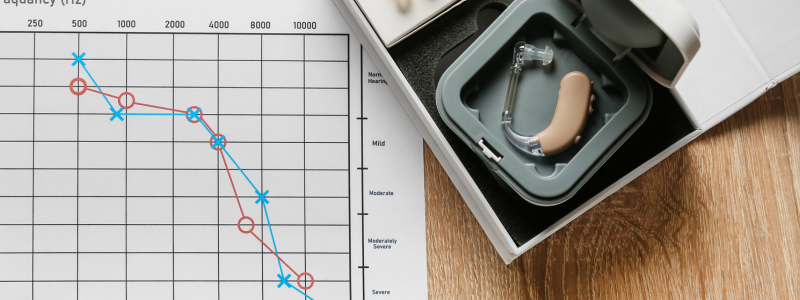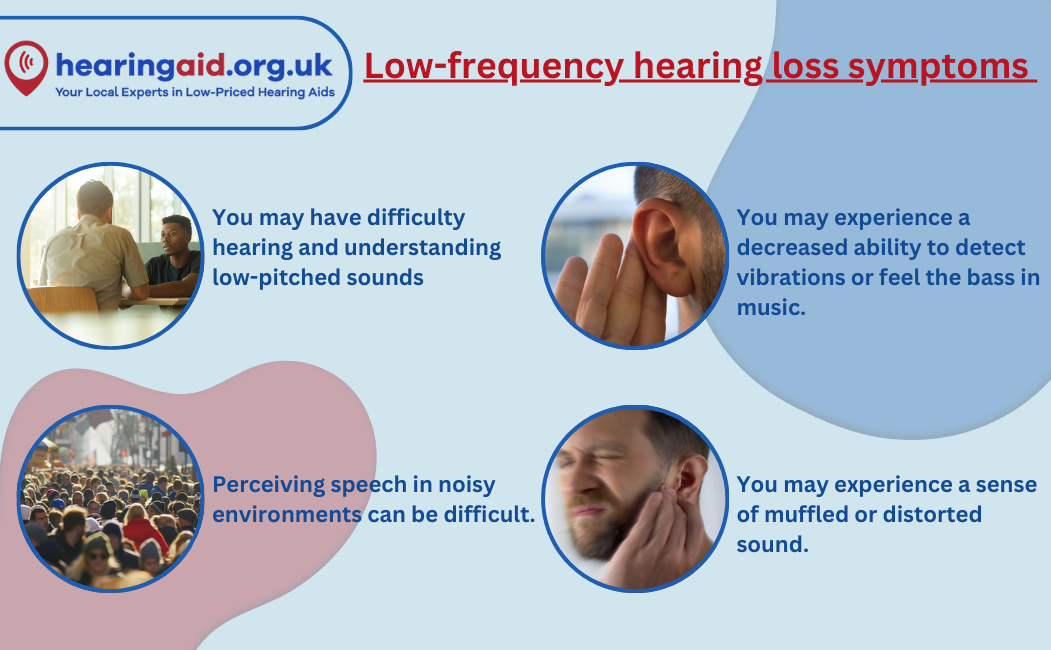Free home visits
with a local audiologist

Head of Online Medical Content

Audiology Expert at Hearing Aid UK

Low-frequency hearing loss involves difficulty hearing sounds in the lower pitch range. It can result from various factors including ageing, genetic predisposition, or exposure to loud noise. Symptoms may include trouble understanding speech and detecting certain environmental sounds.
Treatment often involves hearing aids or other amplification devices tailored to address low-frequency sounds. In this article, we will also explore the causes, symptoms, impact, and treatment options associated with low-frequency hearing loss.
Hearing loss affects many people across the UK, this article explores the specific type known as low-frequency hearing loss. Low-frequency sounds are characterised by their lower pitch and include sounds such as the rumbling of thunder, the deep bass notes in music, and the low tones of human voices.
While high-frequency hearing loss is more widely recognised, low-frequency hearing loss presents its own unique challenges. Understanding the causes and risks associated with low-frequency hearing loss is crucial for prevention, early detection, and targeted treatments.

Low-frequency sounds are characterised by their lower pitch and longer wavelengths. These sounds typically range from 20 to 250 Hertz and include deep bass tones, the thumping of drums, and the rumbling of machinery.
Due to their longer wavelengths, low-frequency sounds can travel further distances and penetrate obstacles more effectively than high-frequency sounds. Understanding the unique qualities of low-frequency sounds is essential in comprehending the specific challenges and impact associated with low-frequency hearing loss.
What should I look out for in regard to low-frequency hearing loss? Individuals with this type of hearing loss often have difficulty hearing and understanding low-pitched sounds, including voices of certain genders or deep tones in music. They may experience a decreased ability to detect vibrations or feel the bass in music.
Additionally, speech perception in noisy environments may become challenging, as low-frequency sounds often contribute to background noise. Other common symptoms include a sense of muffled or distorted sound, difficulty locating sounds, and an increased reliance on visual cues for communication.

Can I protect myself from low-frequency hearing loss? Low-frequency hearing loss can be caused by a variety of factors, both acquired and hereditary. Some common causes include exposure to loud noises over an extended period of time, certain medical conditions, genetic predisposition, and ageing.
Prolonged exposure to high-intensity low-frequency sounds, such as machinery noise or loud music, can damage the delicate structures of the inner ear responsible for processing these frequencies.
Medical conditions like Meniere's disease and otosclerosis (the hardening of the hairs in the ear), as well as certain medications known to have ototoxic effects, can also contribute to low-frequency hearing loss. Additionally, as we age, the natural degeneration of the auditory system can lead to a gradual decline in our ability to perceive low-frequency sounds.

Hearing healthcare professionals employ various diagnostic tests to assess the extent and nature of the hearing loss. One common test is pure-tone audiometry, which measures an individual's hearing thresholds across different frequencies, including low frequencies.
The results are plotted on an audiogram, providing a comprehensive picture of the individual's hearing abilities. Speech audiometry may also be conducted to evaluate the person's speech perception and understanding in both quiet and noisy environments.
Furthermore, additional in-depth tests may then be used to evaluate the condition of the middle ear, cochlea, and auditory nerves in certain cases. These diagnostic tests help clinicians determine the type, severity, and underlying causes of low-frequency hearing loss - guiding the development of personalised treatment strategies.
Can low-frequency hearing loss be cured? While there is no cure for low-frequency hearing loss, several treatment options can help individuals manage their condition and improve their quality of life. The choice of treatment depends on factors such as the severity of hearing loss, the underlying cause, and the individual’s specific needs.
Treatments include:

Low-frequency hearing loss can have a significant impact on an individual's ability to perceive and understand deep sounds, affecting their enjoyment of music, speech comprehension, and overall communication in various environments. These effects can all lead to a sense of isolation and reduced quality of life.
Making certain adjustments in daily life and the environment can help, including minimising exposure to loud noises, optimising room acoustics, and using visual cues in communication.
Friends and family can provide support and help by practising clear and direct communication, using visual cues, being patient and understanding, and choosing environments that minimise background noise such as meeting in quiet cafes over loud bars.
Low-frequency hearing loss presents unique challenges for individuals, impacting their ability to perceive and understand deep sounds and affecting their overall communication and quality of life.
By understanding the causes, symptoms, and impact of low-frequency hearing loss, we can ensure a speedy diagnosis and appropriate treatment strategies can be initiated, including the use of hearing aids.
It is essential to recognise the significant impact of low-frequency hearing loss and implement coping strategies, while friends and family can play a major role in providing support and assistance.
Raising awareness and fostering an inclusive environment can help individuals with low-frequency hearing loss lead fulfilling lives despite these challenges.
If you would like to ask us anything surrounding this article, need additional support on hearing aids, hearing loss, or booking a hearing test - call us free on 0800 567 7621
 I have difficulty hearing in noisy places
I have difficulty hearing in noisy places  High-Pitched Sounds Like Birdsong Are Fading. Do I Have Hearing Loss?
High-Pitched Sounds Like Birdsong Are Fading. Do I Have Hearing Loss?  Asking people to repeat themselves frequently. Do I have hearing loss?
Asking people to repeat themselves frequently. Do I have hearing loss? Do not spend hundreds of pounds without getting a second opinion from us.
 Not only are the prices great, but the service is fantastic! Many thanks to your team.
Not only are the prices great, but the service is fantastic! Many thanks to your team.If you are looking at this page then it is likely that an audiologist has suggested that you purchase this particular hearing aid, so is this the best model for you?
In general, any audiologist will always recommend to you the model that best suits your needs. Here is a useful checklist to make sure that is the case.
If in doubt, feel free to give us a call. That's what we're here for. In the meantime, read all about our review of the best hearing aids for 2025 here
If you have significant hearing loss in both ears, you should be wearing two hearing aids. Here are the audiological reasons why:
Localisation: The brain decodes information from both ears and compares and contrasts them. By analysing the minuscule time delays as well as the difference in the loudness of each sound reaching the ears, the person is able to accurately locate a sound source. Simply put, if you have better hearing on one side than the other, you can't accurately tell what direction sounds are coming from.
Less amplification is required: A phenomenon known as “binaural summation” means that the hearing aids can be set at a lower and more natural volume setting than if you wore only one hearing aid.
Head shadow effect: High frequencies, the part of your hearing that gives clarity and meaning to speech sounds, cannot bend around your head. Only low frequencies can. Therefore if someone is talking on your unaided side you are likely to hear that they are speaking, but be unable to tell what they have said.
Noise reduction: The brain has its own built-in noise reduction which is only really effective when it is receiving information from both ears. If only one ear is aided, even with the best hearing aid in the world, it will be difficult for you to hear in background noise as your brain is trying to retain all of the sounds (including background noise) rather than filtering it out.
Sound quality: We are designed to hear in stereo. Only hearing from one side sounds a lot less natural to us.
Fancy some further reading on this topic? You can read about why two hearing aids are better than one in our article, hearing aids for both ears, here
For most people, the main benefit of a rechargeable hearing aid is simple convenience. We are used to plugging in our phones and other devices overnight for them to charge up. Here are some other pros and cons:
For anybody with poor dexterity or issues with their fingers, having a rechargeable aid makes a huge difference as normal hearing aid batteries are quite small and some people find them fiddly to change.
One downside is that if you forget to charge your hearing aid, then it is a problem that can't be instantly fixed. For most a 30-minute charge will get you at least two or three hours of hearing, but if you are the type of person who is likely to forget to plug them in regularly then you're probably better off with standard batteries.
Rechargeable aids are also a little bit bigger and are only available in Behind the Ear models.
Finally, just like with a mobile phone, the amount of charge you get on day one is not going to be the same as you get a few years down the line. Be sure to ask what the policy is with the manufacturer warranty when it comes to replacing the battery.
Looking for more information on rechargeable hearing aids? Read our dedicated page on the topic here
For most people, the answer is yes. But it's never that simple.
The majority of hearing problems affect the high frequencies a lot more than the low ones. Therefore open fitting hearing aids sound a lot more natural and ones that block your ears up can make your own voice sound like you are talking with your head in a bucket. Therefore in-ear aids tend to be less natural.
However the true answer is we can't tell until we have had a look in your ears to assess the size of your ear canal, and until we have tested your hearing to see which frequencies are being affected.
People with wider ear canals tend to have more flexibility, also there are open fitting modular CIC hearing aids now that do not block your ears.
There is also the age old rule to consider, that a hearing aid will not help you if it's sat in the drawer gathering dust. If the only hearing aid you would be happy wearing is one that people can't see, then that's what you should get.
Most people can adapt to any type of hearing aid, as long as they know what to expect. Have an honest conversation with your audiologist as to what your needs are.
Generally speaking, six or more. Unless it's none at all.
The number of channels a hearing aid has is often a simplistic way an audiologist will use to explain why one hearing aid is better than another, but channels are complex and it is really not that straightforward. Here are some reasons why:
Hearing aids amplify sounds of different frequencies by different amounts. Most people have lost more high frequencies than low and therefore need more amplification in the high frequencies. The range of sounds you hear are split into frequency bands or channels and the hearing aids are set to provide the right amount of hearing at each frequency level.
Less than six channels and this cannot be done with much accuracy, so six is the magic number. However, a six channel aid is typically very basic with few other features and is suitable only for hearing a single speaker in a quiet room. The number of channels is not what you should be looking at, it's more the rest of the technology that comes with them.
As a final note, different manufacturers have different approaches. One method is not necessarily better than any other. For example, some manufacturers have as many as 64 channels in their top aids. Most tend to have between 17 and 20. One manufacturer has no channels at all.
Hearing aids are easily lost, misplaced or damaged and typically are one of the most expensive personal possessions an individual can own. We offer hearing aid warranty coverage for £80 per year per aid. Find out more about this service we provide here
All our audiologists use the very latest technology and provide the full range of tests to accurately measure your hearing for free. Find out about what hearing healthcare services we offer all our customers here
Hearing Aid UK offers all their customers free home visiting services, even in a care home environment, for no extra cost. Including hearing tests, fittings, maintenance, check-ups and much more in the comfort of your own home and at your convenience. Find out more information about our home visits here
Here, at Hearing Aid UK, we are dedicated to offering low hearing aid prices. We achieve this by having no head office and low marketing costs. Our hearing aid prices are amongst the lowest you will find anywhere in the world. Explore our prices, brands, and models here
When we refer to a product as 'Latest Launch', we mean it is the latest to be released on the market.
When we refer to a product as 'New', we mean that the product is the newest hearing aid model on the market.
When we refer to a product as 'Superseded', we mean that there is a newer range available which replaces and improves on this product.
When we refer to a product as an 'Older Model', we mean that it is has been superseded by at least two more recent hearing aid ranges.